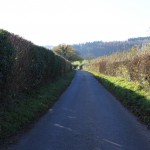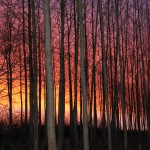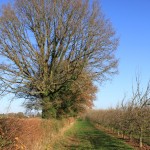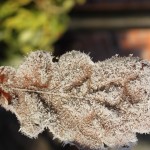Category Archives: The Lane
Thursday 4 December
I turn into the Spinney at the moment a clock announces the time. It must be our local church about a mile away to the south west, although others are audible with the wind in the right direction. Parishes are units of sound as well as government, their borders regulated by the atmosphere. Their character, too, the chimes I have just heard plodding and sombre in tune with the cloud. The lane comes under a number of jurisdictions: sensory as well as procedural, imagined no less than real. I think of labourers in the fields on either side counting down the hours. Wakeful nights made sonorous and companionable. Local conscripts in the trenches dreaming of bells. Whole lives were spent within earshot of their summons, an experience we think of as limiting – although my taste of it this past year has not been so bad. As others have pointed out, there is something to be said for knowing a small world well.
My walk proceeds, one of those days when noticing requires little effort or elaboration. The empty can which landed in the hedge has found its way to the ground, perhaps blown there, although it has not been windy; dislodged by a scavenger; or having its support taken away by the shedding of leaves. The splinter of old road sign, recumbent in the verge, has its concave side facing upwards and is filling with debris from the oak overhead. I notice, however, that nothing is falling from the trees today, a moratorium hard to explain given the descent previously noted in all types of weather. The grass in the Paddy looks very green but the central part of the field is occupied by a floppy-eared plant which covers the earth with the diligence of a crop, not the ragedness of a weed. Birds fidget in front of the white cottage: tree sparrows, blue tits and a couple of chaffinches, dropping to the ground. These observations are loyal to what I intended in the lane, events recorded without regard to their significance. A buzzard crosses in front of me, its wings shrugging to maintain altitude, and I see myself through its eye: upright, earthbound, indigenous.
5 November
It seems fitting to describe an evening walk today, when the promise of bonfires and fireworks is made by a clear sky with an all-seeing moon. One night short of being full, it resembles a circle drawn freehand, the circumference slightly dented. The technical term is waxing gibbous, which sounds like a rock band or Restoration wood carver, and its albedo, meaning the ratio of reflected to non-reflected light, seems particularly strong. Yet this borrowed brilliance is gentle on the eye, the outline clean, the glare commuted to something watchable.
I start at the fire in Mistletoe Orchard. The whizz-bangs have finished and not everyone stays but there are enough half-lit figures to assert the lineage of such gatherings. Early humans frightened of the night. Witches and heretics burning. Childhood with its offer, still to be weighed, of excitement and danger. I am the last to leave, and the only one to head outwards rather than going home. The Spinney has never seemed darker, the plantation to my left never more of a vision. It suggests another attempt at drawing, the poplars not quite straight, not exactly parallel. Or a huge brush with treetops for bristles. Or, with its stillness and mantra-like repetition of shapes, it is the place where I glimpsed enlightenment, images summoned but quickly exhausting themselves to leave the sanctum unoccupied, a stillness perfect for meditation.
Out in the open the full glory of the night is disclosed: black shadows, rockets glittering miles away. And with it the nature of moonlight’s paradox, everything clear yet unrevealed. The hunched profile of hedgerows. The trees on Flanders Hill dreamily insubstantial. The coastline of an oak canopy, indented with little fjords, but not its landmass, its wooden heart. Torchlight dances ahead of me and picks up something on the road: a dead blackbird, hit by a car, the tarmac dainty with jewels of dark blood. It looks pagan, a sacrifice, a warning to go no further. But with its wings fanned and head thrown back it could also be dancing – a mating ritual, a victory strut or some other exotic ecstasy. Such is the spell cast by this negative light. Everything familiar and disconcertingly strange.
26 October
The clocks have gone back and although my starting time is no different the morning feels more advanced. My wife, who tags along, says she and Dougie are bored with the lane and takes him into the Cloves for a run. I make a joke about desertion but she has a point. Now the heyday of summer is past there is little new to see and only so much one can say about the colour of leaves. But I have been surprised too often to doubt something will turn up, and if for once nothing does – well, I can write about that.
Liberated from the tugging lead I follow my own instincts, stopping to listen when a wren strikes up, the shrillness nagging like tinnitus. Then movement distracts me among the ivy flowers. I was wrong about the bees, there are still a few scraping the barrel for pollen, and more than one wasp which, overcoming my revulsion, I look at more closely. I want to believe they have hatched from the parasitic growths seen during summer but they look too large and will not keep still long enough to identify. I have hated them since being stung on the tongue while drinking lemonade. The barb hardly penetrated, but like Captain Hook with his crocodile I suspect them all of wanting to finish the job. Yet an interest in wasps is implied by my fascination with galls. The challenges of natural history are not confined to one’s powers of observation.
A gap in the hedge interrupts this reverie and through it I see that Tall Tree Orchard, having been first with the harvest, is now leading the rush towards winter. It has turned a uniform, blighted shade of yellow and has started to shed leaves, which settle on the earth beneath each row, recently clogged with apples. Drawing level with a similar window onto the Cloves I look right like a soldier on parade and see no loss of green, but a figure passes through a break in the trees, her hair the copper of late beech. It is a sign – and a sight few mortals get to see: my wife, the goddess of autumn.
9 September
Last night we came close to a frost, the moon huge, the sky clean, the air tingling with cold. Approaching the lane I see the sheep huddled for warmth around one of the trees in Mistletoe Orchard. It looks like a meeting, to plan the day’s rumination perhaps. Dew sparkles in the early light. A buzzard lands on a telegraph pole then lifts off again, the interval so short it resembles a bounce. And here too the apples have begun to drop. I heard the same thing in the Cloves recently, the impact softened by grass but still resounding, the thud momentous somehow if not exactly Newtonian.
The bales have gone from the Paddy and from its counterpart across the B-road on Flanders Hill. I miss them, without quite knowing why. Perhaps it is that for a short time they make something strange of the world, objects explicable in origin but alien in form with their massive, incongruous geometry. I am not sure de Chirico ever painted a rural scene but that is what they call to mind, a landscape made dream-like and anomalous.
It is also noticeable that the grass is already pushing through the stubble, a green shadow on its fair complexion. Last year beet was grown, causing me to misread the flamboyant leaves of dock in the verges. Will the field revert to pasture in this phase of the rotation or be ploughed for another crop to be sown? Either way there is a sense of things coming full circle which, apart from its seasonal connotations, makes me aware of my own year turning. Two thirds of the way into this diary or vigil – I am still not sure what to call it – the lane is beginning to repeat itself. Take the ivy whose berries I noted in January and which took weeks to disperse. The flower heads, posies of yellow florets with green bracts, have given birth to the next wave of fruit, each embryo with a nose cone like the spike on a helmet. Nature repels me sometimes with its indifference to suffering, its ruthless numbers game; but this resurgence of life, whatever form it takes, is poignant and irrepressible.
29 August
The process continues of re-immersing myself in the lane, even yesterday’s wider eyes exposed as partially-sighted. I missed, for example, the first snowberries inside the entrance to the Spinney, white globes hiding coyly among the leaves whose glimmer I mistake at first for light glancing off dew. The same goes for elder’s autumn livery, a still more glaring omission. The berries are ripening fast, as black and glossy as caviar, while its foliage passes through the most bashful of yellows to the faded pink of an old juice stain. A clump of white clover is also on the turn, the bushy heads showing lilac tendencies, while enchanter’s nightshade has not done with summer yet, a more forgivable oversight on my part, the flowers tiny and self-effacing.
It is coming back to me now, the profit I had from studying plants closely. A smooth pea gall on the blade of a rose leaf resembles a piercing on someone’s tongue. And elsewhere I spot a shield bug, common enough it is true but more present to my gaze for some reason: the triangular plate extending backwards from the head, the dark wedge at the end of its carapace, similar in appearance to leaf mould, and a series of notches round the perimeter like marquetry. The first of these is, I read later, the scutellum; the last may reveal the edges of posterior wings. This information draws me in, my desire to be an expert gratified, but obscures the encounter itself and the responses it drew from me. I blow gently, hoping to see the insect move, its fastidious, high-stepping gait fondly remembered; but apart from stirring slightly the bug remains still. Only when I nudge the leaf does it react and I see that the left rear leg is missing while its counterpart on the other side drags lamely. This is a creature with no consciousness of its predicament, that will not experience the imminent snuffing of its life in any way we would recognise. Yet watching it limp towards the base of the leaf I am moved to pity and wonder if that feeling is less worthy of merit than being able to name its parts.
4 June
I think of spring as the most exciting time of year on account of the colour in the verges. Reinforcements are still arriving, witness the giant sow thistle, a truly villainous plant, from whose plump finials yellow brush-heads are squeezing like difficult births. Or the small, three-leafed newcomer with tiny yellow blooms which might be black medick. But as earlier risers fade away I am reminded that flowers are only a means to an end, namely the production of seeds with which the parents can repeat themselves and multiply. Who can fail to be in awe of such resourcefulness and ingenuity? But these qualities applied to nothing other than replication provoke sober thoughts on the nature of existence, even ours with its capacity for registering the paradox. The cosmic accident of life, the greening of a planet, the evolution of language with which to frame these reflections: that all this started, and mostly continues, with the simple, unexamined drive to make copies of genetic code strikes me as both wonderful and deficient in meaning.
To cheer myself up I think instead about the products of all this exhausting effort, which reveal themselves to be no less fascinating or, in their own way, beautiful as flowers. By virtue of its prominence numerically cow parsley is a good place to start. The white umbelifers have mostly given way to small, banana-like clusters of cylindrical pods which viewed en masse have a cross-hatching effect on the eye. No less profuse but camouflaged by the hedges, goosefoot has produced tiny balls covered in stiff hairs on stalks pointing in different directions, each assemblage calling to mind planets or the structure of an atom. Herb Robert’s seeds are contained in green hips from which extend single antennae narrowing towards the end and tipped with a slight thickness or serif. Yet another solution is come up with by Herb Bennet whose red-brown globes bristle with a thick coat of whiskers hard to associate with the yellow flowers that begat them. The satisfaction derived from examining these botanical gadgets lays to rest my earlier melancholy and raises a question. Could the pleasure or benefit inspired by something be its reason to exist?
10 May
Another changeable day with squalls, clouds playing tag and fabulous light. Aside from the odd cow parsley stalk snapped by the wind these conditions fuel the verges’ tropical rates of growth. Below the parsley, and in places almost as tall, hogweed, nettles of all persuasions, garlic mustard, Herb Robert and several varieties of grass elbow each other aside. Lower down the dirty, exhausted leaves of daffodil poke through the crush like victims of a stampede. Bedstraw, almost unnoticed now that everything else is green, reaches a height of six feet or more using the hedgerows for support. Does this allow a final decision to be reached as to which variety it is? Unexpectedly the greatest length, usually straggling but here perhaps able to climb, is awarded by field guides to marsh bedstraw, a species I have ruled out on account of its preference for ditches. And it is earlier to flower than other contenders but there are no signs of colour yet. As with many of my attempts to identify things the jury is still out. Perhaps it is time to accept a balance of likelihood, a majority verdict as it were.
Looking up into one of the great trees I see an oak apple and then another nearby, both of them of a size fully meriting their name. A little further on a sprig like Thursday’s has fallen onto the road and a first glance reveals several galls, most clinging to leaves but one appearing to be fastened onto the wood. On closer examination, however, there is a leaf, so tiny it is dwarfed by the parasite, a piggy backer larger than its pig. Scattered on the ground are many more of the same which have become detached from their moorings to resemble windfalls of currants or berries. The first specimens I found and took home have resisted all attempts to keep them alive so this is another opportunity for a spot of kitchen-worktop dissection. The same fruit-like consistency is exposed but this time a white maggot emerges at the centre. At first sight repulsive, as I might have imagined, like any egg it makes an appeal for protection, our nurturing instincts inherited, ungovernable.
17 April
It is another bright morning, a fierce sun halfway up the sky, the wind cold and gusting from the west. Nothing but unravelled vapour trails mars the blue, which is pure and deep overhead but leaks flavour towards the horizon. Blossom has started to appear in Tall Tree Orchard, the flowers a rich, celebratory pink. Two pigeons bale out of an oak, the startled clatter of wings making the birds look guilty. My eyes adjusting to the light I see that leaves have started to form, the old tree steeling itself for another year. At times like this, and with age on my mind, the cycle of life looks exhausting.
The cuckoo pint attracts my attention for the first time in weeks, its presence taken for granted, its early exuberance upstaged. At first I think the thin green cylinder is a new leaf, yet to unfurl. Then I notice the same thing in other specimens, some of them quite immature. Is this the flower whose likeness to sexual organs has earned the plant its other name, Lords and Ladies? There is nothing for it but to open one up, their frequency in the lane excusing the intrusion. At first there does seem to be a leaf of some kind turned in upon itself, but on tearing at the outer folds I discover the thin, priapic organ known as the spadix, its purple skin concealing pale flesh which has been exposed where my thumb scraped the surface. Soon these cocky little spires will be visible everywhere, but exposing one like this makes me see how extraordinary they are, the upper part of the shaft slightly swollen like a club, the whole thing dense yet pliable. The function of this wand is another question, given that the flowers themselves are tiny and concealed at the base. I suppose it draws pollinators in – but how: by colour, shape or movement in a breeze? At least that is the male source of the epithet accounted for. The distaff side must be the sheath I have just broken into which unwraps to form a hood, shapely and secret within. The country folk who coined the plant’s name had dirty minds.
18 March
Rain cloud, windblown and blotchy, covers the sky. A weak shower begins to fall then thinks better of it. The crow pretending to fly overhead is really being swept by a broom.
On turning into the Spinney I am met by the same dumper truck I saw the other day – or at least the driver is the same, a fair-haired bandit with his face hidden behind a scarf. There are lumps of red clay on the lane – so compacted that when I kick one towards the bank it does not break. At first this action feels public-spirited, but instinct is selfish at heart and it is me I have imagined being peppered with clods spat by passing cars. Or is it playfulness I have regressed to, the small boy making a ball out of anything?
A few minutes later the truck returns preceded by another just like it. Their buckets are full of soil, fertile-looking and claggy. I watch them disappear round the kink in the lane then track their progress along the B-road by means of the amber lights flashing. They turn into the meadow beyond the Paddy and bump over the uneven ground, the lead driver standing at the wheel, legs braced, the small boy in me awake again and enthralled. My eyes run ahead of them and see a spoil heap already head-high at which, one by one, the trucks lurch to a halt and upend their loads. There is a building site not far away. Perhaps the landowner is being paid to receive the waste or has need of it for some earthwork he is planning. Once again I am struck by the clarity of the light and how near this little drama seems to me.
There is something mechanical going on in Tall Tree Orchard as well, making a mindless, grinding sort of noise. Despite the absence of leaves I cannot see what it is, the density of branches surprising. Perhaps they have started to spray, although there is a pyramid of gravel or clinker behind the hedge which may be connected. This is the real sign of spring, not flowers appearing or longer days but farmers with their artillery.





